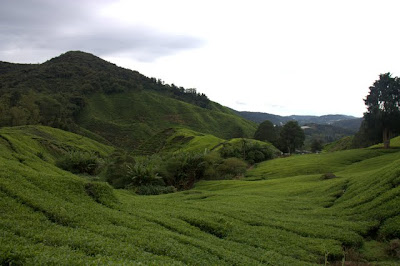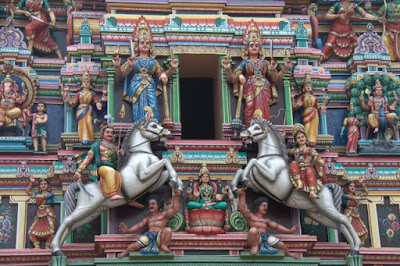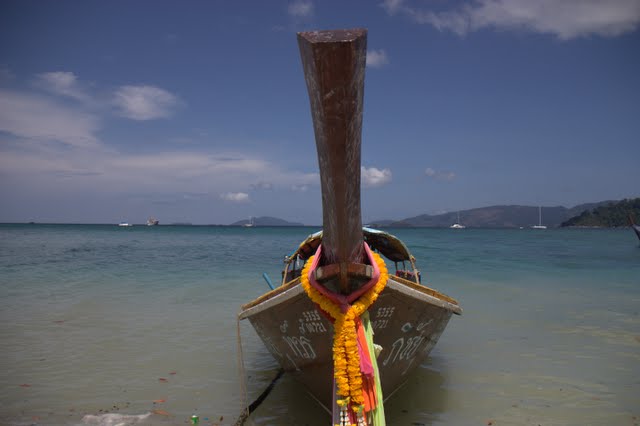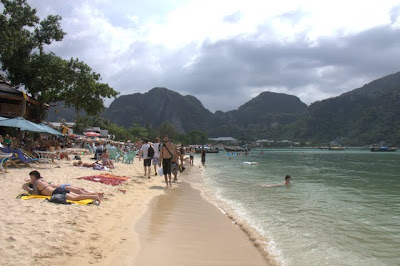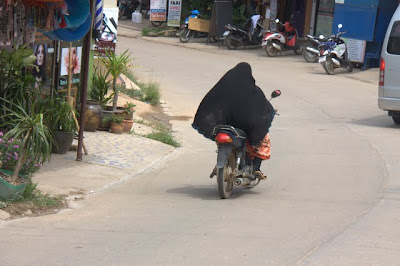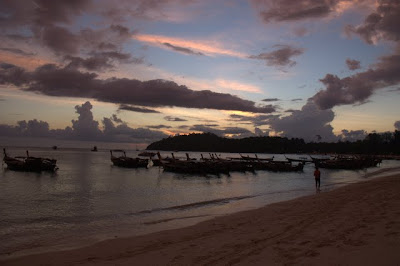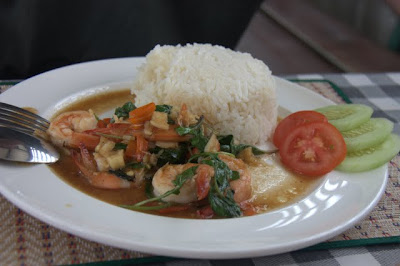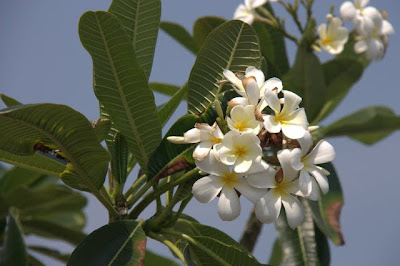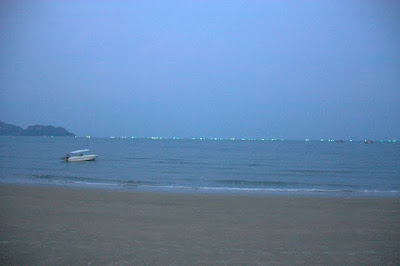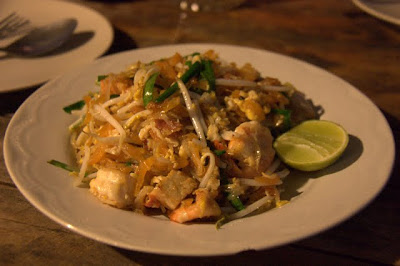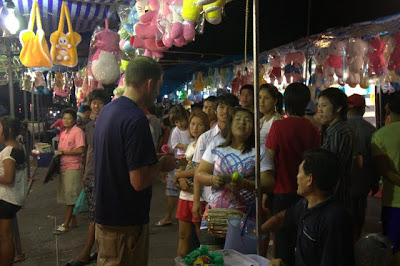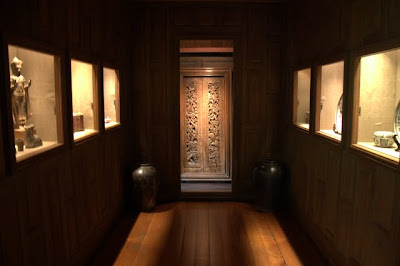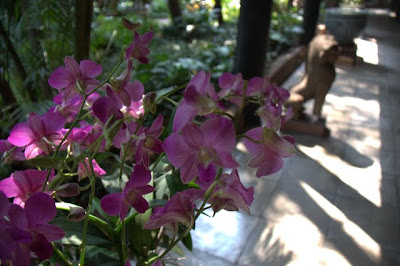The Cost to Take a Trip Around the World
I don’t know about you, but I’m incapable of reading about round the world trips without thinking in the back of my head, well that’s great, but how much did it cost?
The truth is, it depends. The title of this post is somewhat misleading. I can’t tell you how much it will cost you to travel around the world. I can only tell you how much it cost us to travel around the world. Everyone’s travel style and tolerance varies widely. Even in the realm of budget travel, there is a lot of variance. So much depends on things like the season, the country, the current economic state, and the strength of your local currency against the foreign currency, let alone personal factors like can you handle sharing a bathroom? Sleeping in a room with strangers? Taking cold water showers? Not having wi-fi? Going without a/c in the tropics? Taking public transport? Long haul bus rides? Eating on the street? Do you want to hop from country to country or city to city or do you like to stay in one place for a long time? Do you eat ramen to stay on budget or do you splurge on nice meals?
Besides travel style and other variables, the other thing to keep in mind when comparing long-term travel budgets is to determine what the numbers include. Some people include pre-trip costs like vaccinations and gear. Some people don’t. Some people include transport in their daily averages. Other people don’t, or only include certain types. Some people couch-surfed or stayed with friends, whereas others had to pay for all of their accommodations. What about things like prescriptions? Gear you pick up on the road? Travel insurance? Health insurance? Renter’s, home owner’s, or car insurance at home? Storage costs of keeping all your crap? Big ticket items like scuba certifications? Souvenirs for yourself? Holiday or birthday gifts for your family? Bills you have at home? Money you lost selling your home or your car at a reduced rate? There’s many direct and indirect costs that factor into how much a trip of this scale costs. When you’re checking out other people’s budgets, make sure you’re comparing apples to apples.
Even though I can’t tell you how much it costs to travel around the world, I’m sharing our numbers with you in the hopes that it may be a helpful starting point to someone who is trying to put together a budget. So without further ado, here’s our…
GRAND TOTAL
For the two of us to travel to 26 countries over thirteen and half months (409 days, to be precise), it cost us $71,897.46.
In this number, I’ve included the items that are most helpful for someone planning a budget:
– day to day costs (such as accommodation, meals, snacks, drinks, alcohol, activity fees, intercountry transport, tips, etc.);
– miscellaneous costs (laundry, ATM fees, exchange fees, gear and supplies picked up on the road, internet, etc.); and
– intracountry (i.e. cross-border) transport ($11,432.11).
I did not include the following items in the grand total. Many of these costs will vary widely based on your own situation. Plus, we didn’t track our pre-trip costs closely. When you are doing budget research, don’t forget to keep these costs in mind even if you don’t include them in your daily average estimate. Remember other people’s budgets may include some, none, or all of these things.
What’s not included:
– Student loan payments paid while we were away
– Minimal car insurance we kept on our car sitting at home
– Renter’s insurance for our items at home in storage (incidentally, I highly recommend looking into a renter’s insurance policy. It was cheap and turned out to cover items we brought abroad – like our stolen SLR. Our renter’s policy covered most of the loss when our World Nomads travel policy did not).
– Extra money saved as a buffer
– Cost of obtaining wills/power of attorney
– Costs of selling house/temporary housing
– Costs of selling house/stuff/car
– Costs of obtaining passports/passport photos/international drivers’ licenses
– Accountant fees for filing our tax returns while we were away
– Vaccinations, doctor co-pays for physician visits before we left, and prescriptions (guesstimate of about $2,500)
– Supplies & gear purchased before the trip (guesstimate of about $4,000 for everything except our SLR camera and camera gear)
– Storage for items we kept at home (about $1400 for the months we were away)
– High deductible health insurance we purchased to cover us in the United States (about $1,673 for the months we were away)
– World Nomads travel insurance ($1,113 for 12 months; we didn’t extend for the last 6 weeks)
– Scuba certifications ($1,201 for both of us to get our PADI certification in Koh Tao, Thailand and our advanced PADI certification in Perhentian Kecil, Malyasia)
– Gifts & souvenirs (about $2,100; includes our souvenirs, Christmas, birthday/Father’s Day/Mother’s Day/general gifts for family and friends, and shipping)
We’re pretty happy with our grand total. We never intended our budget to be firm and unyielding. Instead, we viewed it as more of a guide. We’re not the best budgeters, but it’s funny how lack of an income and a desire to keep traveling will keep you on track. We originally estimated $60,000. Had we not made the decision to add on 6 more weeks in New Zealand and Hawaii, our costs for our original plan of one year would have been about $62,710.
BUDGET IN CONTEXT
To put those numbers in context, we traveled with our budget in mind and watched expenditures, but we generally went for the best value instead of the absolute cheapest. This means, for example, that we might shell out an extra five dollars in Asia for a hotel room that was cleaner and brighter, or perhaps we would take a more expensive train instead of a bus if it got us there a lot faster. We always did our homework to be smart about our spending. We kept a close eye on ways to cut costs, like doing our own laundry when coin-op machines were available, or booking a service directly if it was just as easy to figure it out ourselves, or paying with a international fee-free credit card any place that would take it. We always had a private room and usually had private bathrooms, but from time to time we’d get a room with a shared bathroom if we were in a money saving mood. We sought out rooms with wi-fi and occasionally splurged on a/c. Because we love food and found food to be the way to the heart of a country, we ate almost all of our meals at a restaurant or on the street. We ate what the locals ate most of the time, but threw in some pricier Western style meals when we got sick of the local cuisine. We moved around a fair amount, and followed the weather even if it meant jumping around. We generally only flew when we had to, although we did take a few intercountry flights in India and one in Vietnam. We rented cars in a number of countries, but only compact or older cars. We didn’t shy away from doing activities even if they were costly, taking a when in Rome approach. (See, e.g. food and beer fest in Belgium; staying in a riad in Morocco and a ryokan in Japan; white-water rafting in Slovenia; cruising with Easy Riders in Vietnam; scuba diving in Thailand, Malaysia and Hawaii; taking a cooking class and visiting an elephant conservation center in Thailand; a candlelight tour of Petra; going up to the viewdeck on the world’s largest building in the UAE; getting up close and personal with whales in South Africa; going jetboating in New Zealand; etc.)
COUNTRY AVERAGES
There’s no doubt that WHERE you travel constitutes the biggest difference in your overall trip cost. Traveling through countries that are not as developed will drastically reduce your costs. We averaged $97.54 a day in countries that were generally less developed than at home – think of the type of places where cash is king. Our average was almost double in countries that were more developed, or about $190.69 a day. On the other hand, don’t assume that just because a country is less developed that it automatically is inexpensive. We found countries like Morocco and Jordan to be much pricier than countries like Laos and India (but much cheaper than countries like Spain and South Korea).
(Note: In order to give you an idea of what it costs to travel through different types of countries, these daily averages only include day to day costs (such as accommodation, meals, snacks, drinks, alcohol, activity fees, intercountry transport, tips, etc.) and miscellaneous costs (laundry, ATM fees, exchange fees, gear and supplies picked up on the road, internet, etc.). They do NOT include intracountry (i.e. cross-border) transport).
No big shocker here, but it was our experience that your dollar stretches the furthest in Southeast Asia, which is why we spent four months in that region. You really can get really nice rooms for $12-$25 (as long as you are willing to put up with your fair share of not so great rooms in the same price range, as quality can be somewhat inconsistent). And if you are willing to eat on the street (and hopefully you are, because the food is delicious and that’s how Southeast Asians eat), you really can get dinner for two for a couple of dollars. Our daily average in Southeast Asia was $81.70 a day, and it would have been possible to go much lower. Our daily average in Asia overall was $109.09 – flanked by a very expensive Japan on one end and a very cheap Laos on the other.
By sticking mostly to Central Europe, our European daily average was $175.92. (Note: our earlier post about European costs did not include intercountry transport, which is why those figures were lower).
Fiji – $53.48
- Total costs: $53.48
- # of days: 1
- Notes: We were only there for a long layover.
Laos – $59.82
- Total costs: $1,435.68
- # of days: 24
- Notes: The cheapest country for us!
Germany – $72.71
- Total costs: $218.12
- # of days: 3
- Notes: No lodging costs because we stayed with a friend.
South Korea – $74.10
- Total costs: $740.98
- # of days: 10
- Notes: No lodging costs for 7 days while we stayed with a friend.
Thailand – $80.44
- Total costs: $4,021.83
- # of days: 50
- Notes: Love Thailand! Includes travel through the islands during high season. We also did a lot of shopping/replenishing in Thailand so that is reflected in the cost.
Malaysia – $82.92
- Total costs: $1,243.84
- # of days: 15
- Notes: Similar in cost to Thailand, but we found lodging value to be better in Thailand. Transport in Malaysia tended to be nicer, though.
Cambodia – $91.53
- Total costs: $1,006.84
- # of days: 11
- Notes: Cambodia is pretty inexpensive, but two costs drove up the price somewhat: eating at restaurants where funds go to NGOs and fees for Angkor Wat.
Vietnam – $100.16
- Total costs: $2,504.03
- # of days: 25
- Notes: These costs drove up the price: one internal flight and guided tours (including a three day, two night Easy Rider tour, hiring a driver after Sean got sick to see the Vihn Moc Tunnels, and a mid-range overnight Halong Bay tour. Otherwise, Vietnam is a good value; you do get more for your money in lodging and food than the rest of SE Asia.
India – $107.09
- Total costs: $3,426.74
- # of days: 32
- Notes: India’s food and lodging are inexpensive. In fact, we found increasing your budget does not always bring a corresponding increase in quality. Costs are higher because we flew internally several times, including to the Andaman Islands.
Hungary – $108.78
- Total costs: $870.24
- # of days: 8
- Notes: Hungary is a good value in Europe!
Poland – $120.63
- Total costs: $482.50
- # of days: 4
- Notes: We only there for a short time, stayed solely in Krakow and ate pierogies most of the time.
UAE – $121.64
- Total costs: $243.28
- # of days: 2
- Notes: We were there twice. The first time, only to sleep in a hotel. The second time, we had a really long layover and went to the Burj Kalifa.
NYC – $129.74
- Total costs: $259.47
- # of days: 2
- Notes: This is for 2 days, one night. Our tiny hotel room alone was more than the daily average.
France – $130.54
- Total costs: $1,958.05
- # of days: 15
- Notes: No lodging costs except for one night in a B&B in Mont St. Michel and an air mattress because we stayed with a friend in Paris.
Czech Republic – $149.21
- Total costs: $1,193.71
- # of days: 8
- Notes: We were mainly in Prague, except for a day trip to Plzen. Costs tend to be higher in Prague, but you get a lot for your money. Beer is really cheaper than water here!
Jordan – $149.87
- Total costs: $1,348.84
- # of days: 9
- Notes: The activities in Jordan drive up the cost, especially the entrance fees to Petra.
Croatia – $161.39
- Total costs: $2,582.17
- # of days: 16
- Notes: This includes island hopping by ferry and a car we rented to go to Sean’s family’s hometown and Plitvice National Park. Food tended to be expensive (and average).
Slovenia – $175.83
- Total costs: $1,406.67
- # of days: 8
- Notes: This includes a car we rented for part of the time.
Morocco – $180.68
- Total costs: $2,710.17
- # of days: 15
- Notes: This includes a rental car and shady fees charged by the rental company.
Portugal – $186.78
- Total costs: $1,307.47
- # of days: 7
- Notes: This includes a rental car.
Northern Ireland – $195.51
- Total costs: $1,173.03
- # of days: 6
- Notes: This includes a rental car.
Spain – $202.83
- Total costs: $4,665.01
- # of days: 23
- Notes: This includes a rental car for a few days.
New Zealand – $205.03
- Total costs: $6,150.98
- # of days: 30
- Notes: Includes campervan rental in shoulder season. We did cook a lot, but when it rained for days on end, we ate out more than we planned to get us out of our campervan.
South Africa – $222.89
- Total costs: $6,017.93
- # of days: 27
- Notes: This includes a rental car.
Japan – $237.02
- Total costs: $7,110.45
- # of days: 30
- Notes: This includes a Japan Rail Pass.
Hawaii – $237.36
- Total costs: $2,136.22
- # of days: 9
- Notes: This includes a rental car.
Ireland – $261.03
- Total costs: $3,654.45
- # of days: 14
- Notes: This figure is estimated; we lost track of our budget quickly after many a round of Guinness. Costs are also higher because we rented a car and went out more than usual while our friends were visiting.
Belgium -$271.59
- Total costs: $543.17
- # of days: 2
- Notes: This just for a 2 day, one night trip to Brussels. Again, costs were probably higher because we drank a lot with our friend (alcohol will get you every time!) and bought an excessive amount of chocolate.
SETTING THE BUDGET AND MAKING IT HAPPEN
Traveling around the world sounds like a pipe dream, but all it takes is prioritizing travel above other things in your life, whether it be your car, your house, your wardrobe, your gadgets, etc. Getting Sean’s sweat equity out of our fixer-upper before we left was instrumental increasing our money stockpile, but so was living well below our means and several years of saving. If you want to do it – really want to do it in reality, not just in theory – you can make it happen. And you should make it happen. Because I can tell you, as much as it stung to find out in the middle of India that the sellers to whom we sold our house – you know, the one that we poured our hearts and souls into for four years – sold the house for $30,000 more less than a year after we sold it to them, the sting dissipates quickly when you realize, holy crap, I’m in India.
If you want to travel but don’t have the ability, desire, or time to save $60,000 or $70,000, don’t be scared by our numbers. It is absolutely possible to travel around the world for a long period of time for less than we spent. Check out two good round-ups of other traveler’s budgets here and here. If you want to or need to spend less, there are many ways to reduce the grand total. (And many ways to increase it, should you want to travel more extravagantly). For example, to cut costs, go for 11 months instead of a year. Go to fewer places for longer periods of time. Stick to countries that are less developed. Go in the off season. Skip pricey activities and stick to soaking up the atmosphere. Select accommodations where you can cook yourself. Consider couch-surfing. Don’t rent a car and take public transport. Limit the amount of fancy gear you buy in advance. There’s lots of ways to save, so don’t let money stop you from traveling. Prioritize what it important to you when traveling – location, accommodations, activities, comfort, value, lowest cost, weather – and the rest will fall into place.
We were fortunate to have enough money in the bank that we didn’t have to be slaves to our budget and could travel, for the most part, without money hindering our choices. We could have spent less, sure, but at this stage in our lives, we wanted a certain level of comfort and decided if we were going to do it, we might as well do it. And we could have spent more; there were times when we felt like spending a little more money would have allowed us to do more things or be more comfortable. But overall, we were happy with our style of travel and what it cost to travel that way. Because there are so many variables, setting your budget will not be an exact science. Once you have an idea of how much it cost other people to travel the world, you may want to pick a number that is feasible for you to save and that you feel comfortable with spending, and work from there to make your travels fit your number.
Riders on the Storm: Two Weeks in Rainy Malaysia
The island of Langkawi in Malaysia is only an hour and half ferry ride away from Ko Lipe, Thailand. When we left Thailand, it was sunny and gorgeous. As soon as we crossed the border into Malyasia (which, by the way, was our third border crossing by water), we were greeted by the storm cloud above. And that’s pretty much how it went during our next two weeks in Malaysia.
The near constant rain, combined with our excitement to leave Asia behind and start a new adventure, meant that Malaysia didn’t get our full attention. We found Malaysia to be pleasant, but not overly exciting, probably half owing to our attitude at the time and the other half owing to Malayisia itself. Malaysia is the most developed country we visited in Southeast Asia, although there was no mistaking that we were still a long way from home. It also was sort of a culmination of our travels, reflecting religions, cultures and ethnicities we had encountered previously on the trip (the Cape Malay in South Africa, Indians in India, and Asians and Muslims in general).
It had been a long time since we encountered a country that is so ethically diverse. About half of the population of Malaysia are Malays, who, according to the Malaysian constitution, are Muslims who practice Malay customs and culture. The government grants certain non-Malay indigenous peoples such as ethnic Thais, Khmers, Chams and natives of Sabah and Sarawak a special “bumiputra” status. These citizens makes up 11% of the population and get certain rights other minorities do not have, such as the 23.7% percent of the population who are of Chinese descent and the 7.1% of the population who are of Indian descent. While the ethnic groups exist in relative harmony, they don’t mix much and there is resentment from the Chinese and Indians, many of whom have been in Malaysia for generations.
All of these ethnicities present in Malaysia means there is a broad array of architecture (including some with a British influence left over from the days Malaysia was a British colony) and most importantly, food. We struck out with our attempts to find delicious Chinese food (I’m sure it’s out there, we just stumbled upon a bad tourist restaurant when we were famished) but our reunification with Indian food did not disappoint, nor did our foray into Malaysian food. Maybe all of this variety means Malaysia is closer to home afterall.
Langkawi
Our quick two night stay on Langkawi, an island slightly more upscale than the backpacker havens we just left behind in Thailand, was mostly spent on the relatively affordable Cenang Beach, where we fit in a trip to the beach before we were rained out. Probably the most exciting thing that happened to us in Lankawi was our realization that we had spent two days living an hour in the past. We didn’t have a guidebook for Malaysia, and no one told us there was one hour difference in time between Thailand and Malaysia. The locals were just as confused as we were when we couldn’t figure out where the 2:30 ferry to Georgetown was. They kept telling us it left; we kept telling them that it couldn’t have because we were sitting at the terminal the whole time. Confusion ensued until we realized that oops, it was 3:30.
Georgetown
Georgetown is known for its UNESCO World Heritage buildings and multi-cultural food. We fit in a pretty good Indian meal and checked out the buildings around town before torrential downpours put an end to our exploration.
Perhentian Islands
We made a major detour over to Malaysia’s eastern coast because we heard the Perhentian Islands were fabulous and not to be missed. We spent 6 nights on Perhentian Cecil, the smaller, more developed island of the two. (More developed being relative, of course; the Perhentians are very low-key with just a sprinkling of locally owned restaurants and general type stores in shack-like buildings). Unfortunately (and I’m sounding like a broken record here, I know) we were plagued by storms again, making our decision to stay in a real concrete room at the relatively expensive Shari-La Resort instead of one of the cheap dilapidated shacks a good one. Perhentian Cecil is small. There’s not a lot to do except snorkel, dive, boogie board, and sun at the beach. We worked on our Advanced PADI scuba certification with Turtle Bay Divers while we were there. The weather progressively declined, but we were able to fit all of our required dives in. The constant runoff made the conditions were horrible – so much that we couldn’t even see our hands during our last dive, let alone any fish – which is a shame, because the diving is supposed to be amazing. This just means we’ll have to go back someday. Oh shucks, force me to go back to a beautiful lush tropical island with blue, blue waters. I just hope our return trip won’t require a speedboat ride where us and our luggage get soaked from the pounding rain and the boat is trying to outrun a giant wave about to overtake us on our way to shore. (By the way, March normally is well outside of monsoon season. All of the locals told us the weather was very unusual – just our bad luck).
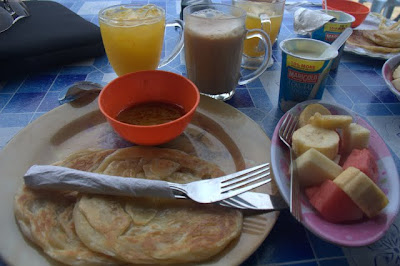
Our most favorite meal in Malaysia - roti canai. Much different than the roti in India or Thailand, this roti is more fluffy and slightly sweet. Malays eat it for breakfast dipped in a spicy curry sauce.

Chicken paprik from Eawan's Restaurant, which was in rain-avoiding sprinting distance from our chalet in the back of Shari-la's resort. Good thing, too, because Eawan is super friendly and his food is tasty.

We stayed at Coral Bay mostly for its great sunsets, which disappointingly never came out in full force during our stay. Dinner on the beach was still enjoyable.

Gorgeous. (But also really rough, which necessitated us trekking up over the hill - sometimes with our scuba equipment - to board the dive boat from the calmer Coral Bay).
Cameron Highlands
Another highlight of our Malaysia travels was the irresistibly green Cameron Highlands. There are crops all over Cameron Highland’s higher elevations like hydroponic strawberries, but the one the Cameron Highlands is most known for is tea. The green blanket of tea bushes over rolling hills is a beautiful sight. We toured the BOH tea plantation and had a cuppa; chowed down on some tasty Malay and Indian food; and hiked through a mossy forest.

We loved the super cheap Indian/Malay restaurants lined up on the main road. We especially liked these ayom (rice pancake like things dipped in coconut milk).

Nasi Lemak, a Malay specialty. It is rice cooked in coconut milk, topped with a hot chili sauce, egg, sardines and cucumber.
Kuala Lumpur
With 1.4 million people, Kuala Lumpur is Malaysia’s largest city and it is also its capital. By the time we rolled into Kuala Lumpur, we were over Asia and ready for New Zealand. Sorry, KL, I’m sure you’re a great city, but you didn’t immediately engage us and so that was that. While we were there, we checked out Chinatown; went to KLCC Suria, a huge mall; and went to the viewing platform of the Petronas Twin Towers (a bit of a snore especially since they’ve already been topped and we’ve been there, done that).
Four Thai Islands
For 24 days in March, we island hopped our way from Thailand to Malaysia, criss-crossing the mainland twice to go from the Gulf of Thailand over to the Andaman Sea and back over to the South China Sea. There was a stretch of 12 straight days where we didn’t hit the mainland, not even to cross the border, moving between islands by ferries of various sizes and shapes. We hit four islands during the Thailand portion: Ko Tao, Ko Phi Phi, Ko Lanta, and Ko Lipe. We had been looking forward to lazy days, and for that, the Thai islands didn’t disappoint, which is why I am able to sum up our two weeks in one post. We had next to zero cultural interactions, and there’s only so many ways to describe our beach bum lives. We visited the islands during the high season and found ourselves surrounded by tourists. Unfortunately, all too many of them were of the young, partying variety, the types to walk around shirtless or hanging out of a bikini hooting and hollering in a rather conservative (and in some of the islands, Muslim) society. The tourism industry is all too eager to cater to these tourists, with shoddily constructed cheap construction tacked up haphazardly next to sewage and water pipes jutting out of the ground, tourist agencies and shops selling the same crap, and most annoyingly, pounding bass music at night. I didn’t expect to be the only ones around, but finding decent accommodation in a quiet location became the bane of our existence. Everything on the islands is more expensive than the mainland and food and accommodation is not nearly as good. But we managed to find some good stuff, we just had to look a little harder. Plus it’s hard to be cranky when the water’s warm and crystal clear, the sand is white and fine, and the sun is shining. Here’s our take (and photos, of course) from the four islands we visited:
Ko Tao
Despite spending 5 nights on Ko Tao, I couldn’t tell you a thing about the island other than it’s great at churning out certified scuba divers at dirt cheap prices. We went there with a one track mind and left after successfully getting our PADI Open Water scuba certification from Buddha View Divers for about $325 a person. Other than that, we saw diddly squat. While we could have made more of an effort to explore, we felt lazy after days spent doing homework for our class and mastering new skills out in the water. So that’s all I have to say about that. (Spoiler alert: we ended up getting our advanced diving certification through Turtle Bay Divers on the Perhentian Islands in Malaysia. More on that later, but if I had to do it over again, I’d probably would have gotten my open water certification through Turtle Bay as well since it was actually cheaper similarly priced [Sean tells me I’m remembering wrong], classes are more intimate and less like a factory, and our instructor Harun was awesome. Nevertheless, the diving schools on Ko Tao get the job done efficiently).
Ko Phi Phi
Ko Phi Phi: definitely winning the award from my least favorite Thai island. You may remember Phi Phi as it was destroyed by the tsunami in 2004. Seven years later, many of the signs of the tsunami are gone, save for new signs displaying the evacuation route. I’m not sure if it was this bad pre-tsunami, but today, it has little charm and it’s crammed full of tourist agencies, trinket shops and clubs. Most people that are there seem to be there to party. In Phi Phi’s defense, we only were there for 2 days and didn’t get a chance to explore beyond the tourist-packed village close to the ferry pier. It rained rather hard while we were there, pinning us in our room and cancelling the boat outing we had planned. And it is a beautiful island, with two crescent shaped bays curving inwards to meet each other. But overall it’s not my cup of tea.
Ko Lanta
Ko Lanta may be the least tropical of the islands we visited, but it probably was my favorite. For starters, it’s bigger than some of the others (but easily circumnavigated in a scooter), meaning that it is less crowded and more spread out. We stayed on Klong Khong Beach on the central western coast, but explored all over the island from the popular Klong Dao Beach in the northwest to the secluded beaches and national park down a dirt road at the southern tip to the less beachy but quaint east coast where the locals live. As we went south in Thailand, the Thai Muslim culture became more predominant, and Muslims operate most of the guesthouses and restaurants on Lanta. The longer we stayed, the more we discovered little hidden gems like Shanti Shanti’s homemade ice creams and sorbets (we tried lime and papaya, chili mango and cinnamon) or Bulan Lanta’s bargain homemade muesli. Our favorite past time on Ko Lanta was sunset watching; there are great sunsets every night up and down Lanta’s long western coast.
Ko Lipe
When you’re daydreaming of escaping to the Thai islands at work, Ko Lipe might be the closest to the picture you have in your mind. Only an hour and half to the Malaysian border by boat and in the middle of a marine reserve, it’s less developed and a little harder to get to than the more northern islands. There’s no pier; the ferry picks up and drops off in the middle of the bay. The water was the bluest and clearest of any of the Thai islands we visited and the sand the whitest and softest. Unfortunately, some of those fabulous beaches can also be strewn with a little too much garbage for my liking. Some people fear Ko Lipe is turning into a mini Ko Phi Phi. Like Ko Phi Phi, motor traffic is prohibited on much of Ko Lipe, and any development that is occurring is shortsighted. It’s also a tad more expensive than even Ko Phi Phi (although we managed to find a decent hut for under $20, albeit without a sink). Hopefully, development won’t run amok, as it is a beautiful gem.
Happy Place, Thailand
Before we headed south all the way to the Thai islands, we stopped at a quiet little seaside town for a few days. The town is called Happy Place. No, that’s not it’s real name, it’s just what Daniel and Helena from the Backpack Foodie christened it after spending two peaceful weeks there in 2009. As he says on his blog, if you ask Daniel nicely, he might reveal the real name of Happy Place to you; he did for me. His descriptions of a small Thai town unblemished by tourism and blessed by fresh seafood reeled me in, and so we set off for a short detour to Happy Place.
Had I known then what I know now, I might have never left. In her broken but steadily growing vocabulary of English, Tchim, the owner of the Coco House, a small local cafe close to our hotel, told me, the islands – very crowded, very expensive. Here – not very crowded, not very expensive. Boy, was she ever right. Don’t get me wrong, we enjoyed the Thai islands – they’re tropical paradise, how could we not – but not as much as we anticipated. More on that to come, but let’s just say traveling in high season makes it hard for the paradise part to shine through.
In Happy Place, on the other hand, nothing gets in the way of its simple pleasures: watching the green lights of the fishing boats bob on the horizon every evening; watching the same boats return in the morning light; eating the fruits of the fisherman’s labors at restaurants on the promenade; hiking up to a great view and dodging thieving monkeys; trying to track down the roving VW bus turned cafe; and listening to the sea lap at the sandy shore.
Happy Place is the type of place that is more likely to be frequented by Thai tourists than farangs. We weren’t the only foreign tourists there, but it wasn’t hard to find yourself surrounded only by locals. We stumbled upon a local fair and besides us, there were only Thai faces around. Sean got a hankering for some bugs and downed some along with a Chang beer much to the amusement of some bystanders. He described them as “earthy” and said they didn’t taste too bad. Blech. I opted for strawberries and doughnuts instead. While we were at the fair, the Thais stared at us in polite curiosity, particularly Sean, as we took our turn playing the fair’s games; we politely stared back at them, trying to figure out why they were sitting in chairs connected by strings to monks up on the stage.
In his post about Happy Place, Daniel wrote that “[i]t’s, sadly, entirely possible that in a few years, we will barely recognize our favorite spot under the concrete of a beach resort” because “like many places before it in Thailand, the vanguard of foreign tourism has already begun its incursion.” Almost two years later, it seems time hasn’t marched quite yet. There’s no banana pancake cafes or booming bass and there’s only one 7-Eleven. Tchim is still there, selling coffee at Coco House and eager to chat about the two farangs that befriended her in her early weeks of operation. The Deemer family still cooks up delectable pad thai and som yam and their cat still scarfs down any of the delicious seafood that it can get its paws on. In other words, Happy Place is still happy.
Bangkok, Redux.
Going back to Bangkok after Hanoi was like going to see an old friend. We found we loved Bangkok as much as we did the first time three months prior, save for the muggier weather. We contemplated staying elsewhere but you just can’t beat the fabulous Roof View Place. We wasted no time visiting old favorites. We were happy to see our Pad Thai Lady again; we missed her so. And just when you thought a good thing couldn’t get better, a couple opened a coffee shop with chocolately cupcakes several doors away from the Pad Thai Lady. There was another round of visits to the Peanut Butter and Banana Pancake Lady, the Mango and Sticky Rice Man, the Orange Juice Lady, the movies, the malls, and Ethos Vegetarian Restaurant. Sadly, there was no time for $6 massages, a decision I would come to regret when I realized massages on the islands are at least $8. Outrageous.
We also mixed it up a bit this time, with visits to the Jim Thompson House and a whirlwind ride in a river taxi down one of Bangkok’s side canals. The craziest thing we did was turn left outside Roof View Place instead of staying straight to walk to the bus; it was a whole new world. On your way to work or the grocery store today, take a new way home…you never know what you’ll see.

Flying down the side canals in a water taxi is hands down one of the coolest experiences in Bangkok. You hop on before the boat comes to a full stop and whip down the murky brown water past residential homes displaying lush plants and laundry. The money collectors hanging on outside the boat duck at the underpasses and pull down the retractable roof just in time. It is WILD.
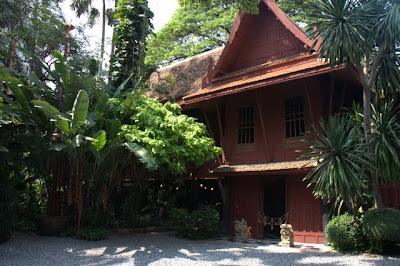
Jim Thompson is a former American CIA agent living in Bangkok who mysteriously disappeared in the 70s. His traditional teak Thai houses and extensive displays of Asian art are on display.











